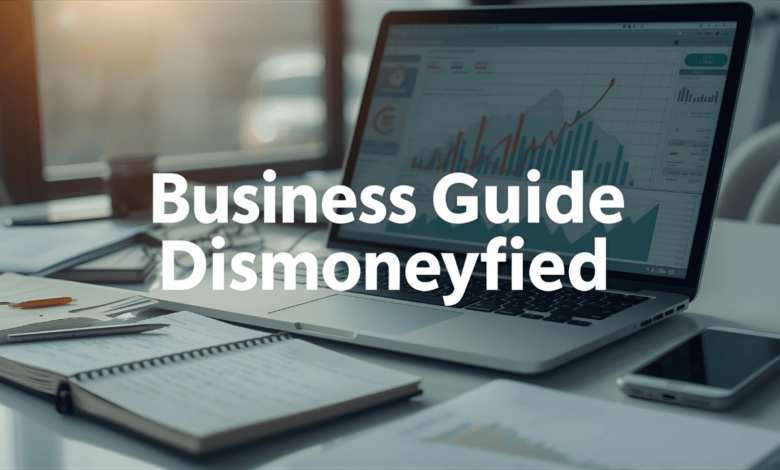business guide dismoneyfied: launch and grow a lean venture without heavy capital

Most people assume you need deep pockets, flashy offices, and heavyweight investors to start a company. In reality, many successful founders begin with clarity, small bets, and fast learning. That’s the spirit behind business guide dismoneyfied: a practical way to build value first, control costs, and use profit to fund growth. This approach puts customer understanding, simple numbers, and smart execution ahead of big spending. If you want to launch or re-shape a venture with minimal resources, business guide dismoneyfied shows you how to do it systematically.
What business guide dismoneyfied really means
At its core, business guide dismoneyfied is about separating progress from heavy cash burn. It encourages you to validate demand early, earn revenue sooner, and keep fixed costs low. Instead of chasing investment as a starting point, you use learning cycles, resourcefulness, and customer payments to drive the next iteration. The goal isn’t starvation; the goal is efficiency, flexibility, and focus on what customers actually value.
Why business guide dismoneyfied matters right now
Markets shift quickly, advertising costs fluctuate, and capital can be hard to access. A leaner style reduces risk while increasing speed. With business guide dismoneyfied, you avoid building features no one needs and commit to continuous testing. You also reduce the stress of high burn rates and give yourself more runway to find true product-market fit. This matters for solo founders, small teams, and even larger companies that want to incubate new ideas without unnecessary overhead.
The mindset shift behind a lean launch
You’re not trying to build the final version; you’re trying to build the first version that teaches you the most.
Key ideas:
- Focus on one painful problem and a narrow audience.
- Trade polish for learning speed in the early weeks.
- Replace assumptions with direct user conversations.
- Treat money as a tool for validated steps, not as the main engine.
- Ship small, measure clearly, and iterate deliberately.
Crafting a clear value proposition
A strong value proposition is the backbone of business guide dismoneyfied. It tells buyers exactly what outcome they get and why it beats their alternatives. Write one sentence that states the audience, the problem, the solution, and the measurable benefit. Then test it with real people. If they can’t repeat it back simply, it’s not yet clear enough. Clarity reduces wasted work and keeps your product, pricing, and messaging aligned.
Minimum viable offer, not maximum possible product
A minimum viable offer is the smallest, clearest way to deliver the promised outcome. In business guide dismoneyfied, you aim to be useful now, then better next week. That could be a service package, a workshop, a simple landing page for pre-orders, or a lightweight product with only the essential feature. The point is to collect evidence: conversations, signups, payments, and retention signals.
Practical steps:
- Write the promise and list only the must-have capabilities to deliver it.
- Remove anything that doesn’t directly contribute to the promised outcome.
- Set a deadline to launch the first version, even if it feels imperfect.
- Capture feedback immediately and adjust the next iteration.
Early revenue before heavy spending
Revenue isn’t just cash; it’s proof that your solution matters. In business guide dismoneyfied, you look for low-friction ways to earn early:
- Pre-sell a cohort program or a small batch of products.
- Offer a paid pilot to a limited number of customers.
- Bundle a service with a simple deliverable that can be productized later.
- Use tiered pricing, with a basic tier that’s fast to deliver.
Early revenue teaches you who values your offer, which channels bring buyers, and what improvements to fund next.
Simple finance that keeps you in control
Complex spreadsheets don’t make a venture healthy. Simple visibility does. With business guide dismoneyfied, track a short set of numbers weekly:
- Cash in and cash out
- Monthly recurring revenue or monthly sales
- Customer acquisition cost and average order value
- Contribution margin and payback time
- Runway at current burn (even if burn is small)
These few metrics, reviewed regularly, prevent surprises and guide sane decisions about pricing, hiring, and marketing.
Marketing that favors brains over budget
You don’t need massive ad spend to get traction. Business guide dismoneyfied leans on high-signal, low-cost channels:
- Talk to users where they already gather: niche communities, forums, local groups, industry Slack or WhatsApp circles.
- Publish useful problem-solving content, case notes, and before/after transformations.
- Run small experiments: short videos, live demos, webinars, or a free diagnostic that leads to paid solutions.
- Partner with complementary creators or small brands for co-promotions.
The goal is to earn trust by helping first, then present a clear offer when interest is high.
A simple content framework that compounds
Use this weekly rhythm:
- One deep problem-solving article or guide
- One short customer story or testimonial
- One quick tip or checklist your audience can use today
- One offer with a clear next step
This cadence pairs perfectly with business guide dismoneyfied because it builds demand while staying lightweight.
Operations that stay lean and flexible
Think in terms of processes, not departments. Map a simple flow from lead to payment to delivery to follow-up. Then remove friction with just-enough tools:
- A basic CRM or spreadsheet for leads and customers
- Automated invoicing and receipts
- Templates for proposals, onboarding, and updates
- A shared task board to track deliverables
Keep fixed costs small and use contractors or part-time help until volume justifies full-time roles. The operating principle of business guide dismoneyfied is to convert variable costs into learning and revenue, not into permanent overhead.
Tool selection without bloat
Pick tools you can master in days, not months. If a tool saves time every week and costs little, it’s worth it. If it requires heavy training for marginal gains, skip it for now. Revisit your stack each quarter and prune anything that no longer moves the needle.
Pricing and packaging that support learning
Prices communicate value and shape expectations. Start with a narrow package that promises a concrete transformation. Set an initial price that reflects the outcome, not just your time, and adjust quickly as evidence grows. Business guide dismoneyfied encourages versioned packages:
- Entry package for fast wins
- Standard package for most buyers
- Premium package with added outcomes or faster turnaround
This structure lets you test willingness to pay and allocate effort where margins are healthiest.
When and how to scale
Scale when three signs align: repeatable demand, positive unit economics, and a delivery process that stays reliable as volume rises. At that point, business guide dismoneyfied supports measured expansion:
- Invest in channels with proven acquisition costs and predictable conversion.
- Document delivery so more people can produce the same quality.
- Add fixed costs only after the revenue to cover them is stable.
- Expand the offer catalog by productizing your best custom work.
Growth becomes an outcome of systems you’ve tested, not a gamble fueled by hope.
Pitfalls to avoid on the lean path
Even with a disciplined approach, there are traps. Business guide dismoneyfied calls them out clearly:
- Building too much before any customer commits
- Confusing activity with progress
- Ignoring retention while chasing new leads
- Pricing too low for too long
- Adding tools or hires to solve problems that clarity could solve
Prevent these by setting weekly targets tied to outcomes: conversations booked, pilots sold, repeat purchases, and net revenue.
A 30-day action plan to put business guide dismoneyfied to work
Week 1
- Define your audience and the single problem you solve best.
- Draft a one-sentence value proposition and three offer options.
- Line up five conversations with real prospects.
Week 2
- Publish a simple landing page with the minimum viable offer.
- Invite early adopters to a paid pilot or pre-order list.
- Share two useful pieces of content that address the core problem.
Week 3
- Deliver to your first customers and gather structured feedback.
- Track cash in/out, conversion, and delivery time.
- Adjust messaging and pricing based on what buyers valued most.
Week 4
- Double down on the two channels that produced the best leads.
- Create templates for proposals, onboarding, and reporting.
- Plan the next 30 days with one clear revenue goal and supporting tasks.
This month-long sprint establishes momentum while staying faithful to business guide dismoneyfied principles.
Regional and small-team considerations
If you operate in a market where purchasing power varies and logistics can be tricky, flexibility matters even more. Offer payment plans, bundle services with digital deliverables to reduce shipping complexity, and use local communities for fast validation. Small teams benefit from cross-trained roles and a weekly review ritual that keeps everyone aligned on a few essential numbers. Business guide dismoneyfied thrives in these environments because it rewards creativity and resilience over raw spend.
The enduring advantage of disciplined simplicity
Complexity can feel impressive, but simplicity scales better. When your proposition is clear, your offer is focused, and your numbers are visible, you make better decisions faster. That’s the promise of business guide dismoneyfied: progress you can sustain, customers you understand, and a company that grows because it truly solves a problem, not because it outspends competitors.
Quick checkpoints you can use this week
- Can a stranger explain your offer after reading a single paragraph?
- Do you know which channel produced your last five buyers?
- Is there at least one package with a healthy margin and fast delivery?
- Which task, if automated or templated, would free the most time?
- What would make a customer buy again within 30 days?
These simple questions keep your focus on outcomes and reinforce the habits that business guide dismoneyfied promotes.
Conclusion
The path to a durable business doesn’t require massive budgets or complicated structures. It requires clarity, consistent learning, and a bias for action. By defining a sharp value proposition, shipping a minimum viable offer, earning early revenue, and tracking a handful of metrics, you reduce risk and increase momentum. Business guide dismoneyfied is a practical, repeatable way to do exactly that. Start small, measure honestly, and scale the systems that work. The result is a company built on proof, not on wishful spending.
Frequently asked questions
- What makes business guide dismoneyfied different from traditional startup playbooks?
It prioritizes early customer proof and healthy unit economics over large pre-launch investment, keeping costs flexible until demand is truly repeatable. - How soon should I try to earn revenue with business guide dismoneyfied?
As soon as you can deliver a meaningful outcome, even if it’s a trimmed-down version. Early revenue validates demand and funds the next iteration. - Can a product company use business guide dismoneyfied, or is it only for services?
It works for both. Many product founders begin with paid pilots, pre-orders, or a concierge version before investing in full automation or inventory. - What metrics matter most when following business guide dismoneyfied?
Track cash flow, acquisition cost, average order value, contribution margin, and payback time. Review them weekly to guide decisions. - When should I add full-time hires while using business guide dismoneyfied?
Hire when workload is consistent, margins can support the role, and documented processes ensure quality. Until then, use contractors and focused tools.



